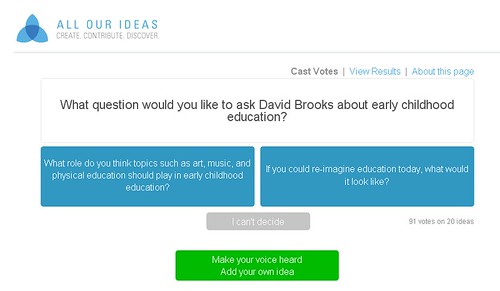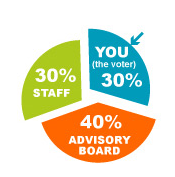Crowdsourcing is the process of organizing many people to participate in a joint project, often in small ways. The results are greater than an individual or organization could accomplish alone. There are many examples of crowdsourcing techniques used by nonprofits and foundations and The Networked Nonprofit devoted an entire chapter to the topic.
Does crowdsourcing enhance or bring value to face-to-face conferences? Where is it most useful? Planning for the overall conference agenda, design of specific sessions, or other ways? Here’s a few examples I’ve seen lately.

Crowdsourcing A Keynote Discussion/Q&A
Next week on March 1-2, the First 5 California and the Water Cooler Joint Conference will take place in Sacramento. The conference brings together professionals who working on early learning research, practice, and policy to promote improvement and expansion of services for children ages 0 to 5 in the state.

On March 2nd, one of the highlights of the agenda is a keynote conversation with David Brooks, New York Times Columnist and Lois Salisbury, Director of Children, Families and Communities Program, The David and Lucile Packard Foundation. The discussion will explore how the needs of California’s youngest children can be brought into the larger education discussion, including how to attract other allies for early childhood education in California.
To generate ideas for questions and how to shape the conversation, the conference is using AllOurIdeas to query early childhood professionals in California for their questions. The platform allows viewers to vote on ideas and add their own. It also generates some statistics and visuals that allow you to easily cull the wisdom of the crowd.
This is a great example of low-risk pilot to understand the process and value of working in these ways. Does crowdsourcing questions — can that raise awareness about the issue, inspire a broader range or or quality of questions, or otherwise contribute to a productive conversation? Stay tuned.
And, of course, if you care about early childhood education in California, be sure to vote or add your questions.
Crowdsourcing the Conference Agenda

Technology Conferences have used crowdsourcing to build the agenda. The SXSW Festival has been using a hybrid approach to crowdsourcing is conference agenda for a couple years. The call goes out to people to design sessions. A description is included and added to the “Panel Picker Site.” Session designers than issue a call to action to their networks to vote for sessions. NTEN has also used a similar crowdsourcing techniques to shape the NTC conference agenda.

Recently Craigslist Foundation did a crowdsourcing experiment to shape the agenda for its annual nonprofit bootcamp. Here’s the recipe for what they did:
1. Internal Brainstorm: The team held a brainstorming session to identify topics and ideas that has been highly rated at past conferences. They took this initial list of 98 ideas and created a series of program ideas – and used AllOurIdeas
2. Reached Out To Networks: They reached out to networks asking people to vote or suggest new ideas. They had a one-month window to actively promote participation. More than 3,000 votes were cast by more than 400 people. An additional 55 session topics were suggested.
3. Used Results To Guide Decisions: They used the results to help them plan program.
This blog post shares some lessons learned for others that might consider doing something similar. What struck me is that you need to use community building techniques – you have highlight ideas as they emerge from the process to inspire others to participate.
How else might you use crowdsourcing techniques for a face-to-face conference? What value do you think it offers?
Beth Kanter is a consultant, author, influencer. virtual trainer & nonprofit innovator in digital transformation & workplace wellbeing.
